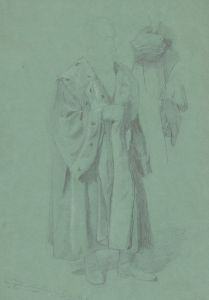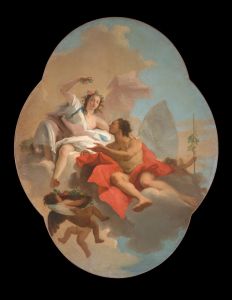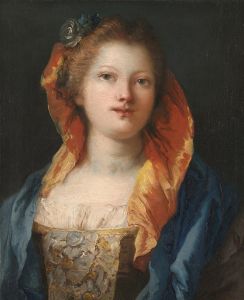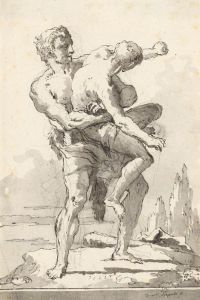
Allegorical Figure Representing Asia
A hand-painted replica of Giovanni Domenico Tiepolo’s masterpiece Allegorical Figure Representing Asia, meticulously crafted by professional artists to capture the true essence of the original. Each piece is created with museum-quality canvas and rare mineral pigments, carefully painted by experienced artists with delicate brushstrokes and rich, layered colors to perfectly recreate the texture of the original artwork. Unlike machine-printed reproductions, this hand-painted version brings the painting to life, infused with the artist’s emotions and skill in every stroke. Whether for personal collection or home decoration, it instantly elevates the artistic atmosphere of any space.
"Allegorical Figure Representing Asia" is a painting by the Italian artist Giovanni Domenico Tiepolo, created in the 18th century. Giovanni Domenico Tiepolo, often referred to as Giandomenico Tiepolo, was born on August 30, 1727, in Venice, Italy, and was the son of the renowned painter Giovanni Battista Tiepolo. Giandomenico was known for his frescoes, paintings, and etchings, and he often collaborated with his father on various projects.
The painting "Allegorical Figure Representing Asia" is part of a series of works that depict the four continents—Asia, Africa, Europe, and America—through allegorical figures. This series was a popular theme in the 18th century, reflecting the European interest in and fascination with the wider world during the Age of Enlightenment and the period of exploration and colonial expansion.
In "Allegorical Figure Representing Asia," Giandomenico Tiepolo employs a classical allegorical style to personify the continent of Asia. The figure representing Asia is typically depicted as a regal and exotic woman, adorned with luxurious and culturally significant attire that reflects the European perception of Asian opulence and mystique. She is often shown with attributes that symbolize the continent, such as a turban, fine fabrics, and possibly holding items like a censer or spices, which were highly valued in Europe.
The painting is characterized by Tiepolo's masterful use of color, light, and composition. His technique includes a delicate balance of vibrant hues and intricate details that bring the allegorical figure to life. The background of the painting may include elements that further emphasize the exotic and distant nature of Asia, such as architectural structures, landscapes, or flora and fauna that were associated with the continent.
Giandomenico Tiepolo's work is notable for its elegance and the way it captures the imagination of the viewer, transporting them to a world of myth and allegory. His ability to blend realism with idealism is evident in this painting, as he creates a figure that is both a representation of a geographical concept and a personification imbued with character and presence.
The painting "Allegorical Figure Representing Asia" is part of the larger artistic and cultural context of the 18th century, where allegorical representations were a common way to convey complex ideas and themes. These works were often commissioned for grand homes, palaces, or public buildings, serving both decorative and didactic purposes.
Giandomenico Tiepolo continued to work and create art until his death on March 3, 1804. His contributions to the art world, including his allegorical paintings, remain significant examples of 18th-century Venetian art and continue to be studied and admired for their artistic and historical value.











